What's inside
What's inside
 Key Ingredients
Key Ingredients

 Benefits
Benefits

 Concerns
Concerns

 Ingredients Side-by-side
Ingredients Side-by-side

Camellia Sinensis Leaf Water
MaskingGlycerin
HumectantHelianthus Annuus Seed Oil
EmollientCorylus Avellana Seed Oil
EmollientGrifola Frondosa Extract
Skin ConditioningCocoglycerides
EmollientHydrogenated Lecithin
EmulsifyingCetearyl Alcohol
EmollientHouttuynia Cordata Extract
Skin ConditioningShea Butter Glycerides
EmulsifyingPanthenol
Skin ConditioningGlyceryl Stearate
EmollientNylon-12
Cetearyl Glucoside
EmulsifyingScutellaria Baicalensis Root Extract
AstringentPaeonia Suffruticosa Root Extract
Skin ProtectingC14-28 Alkyl Acid
Sodium Olivoyl Glutamate
CleansingStearyl Alcohol
EmollientStearic Acid
CleansingBeeswax
Emulsion StabilisingButyrospermum Parkii Butter
Skin ConditioningPinus Pinaster Bark Extract
AntioxidantGlycosaminoglycans
EmollientLupinus Albus Seed Extract
Skin ConditioningGlutathione
Carnosine
Skin ConditioningBehenyl Alcohol
EmollientPalmitoyl Tripeptide-1
Skin ConditioningPalmitoyl Tetrapeptide-7
Skin ConditioningSh-Polypeptide-64
AntioxidantQuercetin
AntioxidantCamellia Sinensis Catechins
AntioxidantTetradecyl Aminobutyroylvalylaminobutyric Urea Trifluoroacetate
Skin ConditioningAcetyl Hexapeptide-8
HumectantCopper Tripeptide-1
Skin ConditioningNicotinoyl Dipeptide-22
Skin ConditioningDipotassium Glycyrrhizate
HumectantGinsenosides
Skin ConditioningMagnesium Chloride
Arginine
MaskingCarbomer
Emulsion StabilisingXanthan Gum
EmulsifyingAdenosine
Skin ConditioningButylene Glycol
Humectant1,2-Hexanediol
Skin ConditioningCyclodextrin
AbsorbentCamellia Sinensis Leaf Water, Glycerin, Helianthus Annuus Seed Oil, Corylus Avellana Seed Oil, Grifola Frondosa Extract, Cocoglycerides, Hydrogenated Lecithin, Cetearyl Alcohol, Houttuynia Cordata Extract, Shea Butter Glycerides, Panthenol, Glyceryl Stearate, Nylon-12, Cetearyl Glucoside, Scutellaria Baicalensis Root Extract, Paeonia Suffruticosa Root Extract, C14-28 Alkyl Acid, Sodium Olivoyl Glutamate, Stearyl Alcohol, Stearic Acid, Beeswax, Butyrospermum Parkii Butter, Pinus Pinaster Bark Extract, Glycosaminoglycans, Lupinus Albus Seed Extract, Glutathione, Carnosine, Behenyl Alcohol, Palmitoyl Tripeptide-1, Palmitoyl Tetrapeptide-7, Sh-Polypeptide-64, Quercetin, Camellia Sinensis Catechins, Tetradecyl Aminobutyroylvalylaminobutyric Urea Trifluoroacetate, Acetyl Hexapeptide-8, Copper Tripeptide-1, Nicotinoyl Dipeptide-22, Dipotassium Glycyrrhizate, Ginsenosides, Magnesium Chloride, Arginine, Carbomer, Xanthan Gum, Adenosine, Butylene Glycol, 1,2-Hexanediol, Cyclodextrin
Water
Skin ConditioningGlycerin
HumectantC12-15 Alkyl Benzoate
AntimicrobialCetearyl Alcohol
EmollientDimethicone
EmollientArachidyl Alcohol
EmollientCetyl Alcohol
EmollientAvena Sativa Kernel Flour
AbrasivePhenyl Trimethicone
Skin ConditioningCetearyl Glucoside
EmulsifyingBehenyl Alcohol
EmollientSodium Polyacrylate
AbsorbentPhenoxyethanol
PreservativePanthenol
Skin ConditioningCaprylyl Glycol
EmollientEthylene/Acrylic Acid Copolymer
Emulsion StabilisingPolyacrylamide
Arachidyl Glucoside
EmulsifyingC13-14 Isoparaffin
EmollientChrysanthemum Parthenium Flower/Leaf/Stem Juice
AntioxidantChlorphenesin
AntimicrobialDisodium EDTA
Pentaerythrityl Tetra-Di-T-Butyl Hydroxyhydrocinnamate
AntioxidantLaureth-7
EmulsifyingCeramide NP
Skin ConditioningWater, Glycerin, C12-15 Alkyl Benzoate, Cetearyl Alcohol, Dimethicone, Arachidyl Alcohol, Cetyl Alcohol, Avena Sativa Kernel Flour, Phenyl Trimethicone, Cetearyl Glucoside, Behenyl Alcohol, Sodium Polyacrylate, Phenoxyethanol, Panthenol, Caprylyl Glycol, Ethylene/Acrylic Acid Copolymer, Polyacrylamide, Arachidyl Glucoside, C13-14 Isoparaffin, Chrysanthemum Parthenium Flower/Leaf/Stem Juice, Chlorphenesin, Disodium EDTA, Pentaerythrityl Tetra-Di-T-Butyl Hydroxyhydrocinnamate, Laureth-7, Ceramide NP
 Reviews
Reviews

Ingredients Explained
These ingredients are found in both products.
Ingredients higher up in an ingredient list are typically present in a larger amount.
Behenyl Alcohol is a type of fatty alcohol (these are different from the drying, solvent alcohols).
Fatty Alcohols have hydrating properties and are most often used as an emollient or to thicken a product. They are usually derived from natural fats and oils; behenyl alcohol is derived from the fats of vegetable oils.
Emollients help keep your skin soft and hydrated by creating a film that traps moisture in.
In 2000, Behenyl Alcohol was approved by the US as medicine to reduce the duration of cold sores.
Learn more about Behenyl AlcoholCetearyl alcohol is a mixture of two fatty alcohols: cetyl alcohol and stearyl alcohol. It is mainly used as an emulsifier. Emulsifiers help prevent the separation of oils and products. Due to its composition, it can also be used to thicken a product or help create foam.
Cetearyl alcohol is an emollient. Emollients help soothe and hydrate the skin by trapping moisture.
Studies show Cetearyl alcohol is non-toxic and non-irritating. The FDA allows products labeled "alcohol-free" to have fatty alcohols.
This ingredient is usually derived from plant oils such as palm, vegetable, or coconut oils. There is debate on whether this ingredient will cause acne.
Due to the fatty acid base, this ingredient may not be Malassezia folliculitis safe.
Learn more about Cetearyl AlcoholCetearyl Glucoside is a surfactant and emulsifier. It can be produced from synthetic of natural sources of cetearyl alcohol and glucose.
Emulsifiers help prevent ingredients from separating, such as oils and waters. It can also be used to enhance the texture of products.
As a surfactant, Cetearyl Glucoside helps during the cleansing process. By gathering all the dirt and oils, it allows these molecules to be washed away easily.
Learn more about Cetearyl GlucosideGlycerin is already naturally found in your skin. It helps moisturize and protect your skin.
A study from 2016 found glycerin to be more effective as a humectant than AHAs and hyaluronic acid.
As a humectant, it helps the skin stay hydrated by pulling moisture to your skin. The low molecular weight of glycerin allows it to pull moisture into the deeper layers of your skin.
Hydrated skin improves your skin barrier; Your skin barrier helps protect against irritants and bacteria.
Glycerin has also been found to have antimicrobial and antiviral properties. Due to these properties, glycerin is often used in wound and burn treatments.
In cosmetics, glycerin is usually derived from plants such as soybean or palm. However, it can also be sourced from animals, such as tallow or animal fat.
This ingredient is organic, colorless, odorless, and non-toxic.
Glycerin is the name for this ingredient in American English. British English uses Glycerol/Glycerine.
Learn more about GlycerinPanthenol is a common ingredient that helps hydrate and soothe the skin. It is found naturally in our skin and hair.
There are two forms of panthenol: D and L.
D-panthenol is also known as dexpanthenol. Most cosmetics use dexpanthenol or a mixture of D and L-panthenol.
Panthenol is famous due to its ability to go deeper into the skin's layers. Using this ingredient has numerous pros (and no cons):
Like hyaluronic acid, panthenol is a humectant. Humectants are able to bind and hold large amounts of water to keep skin hydrated.
This ingredient works well for wound healing. It works by increasing tissue in the wound and helps close open wounds.
Once oxidized, panthenol converts to pantothenic acid. Panthothenic acid is found in all living cells.
This ingredient is also referred to as pro-vitamin B5.
Learn more about Panthenol